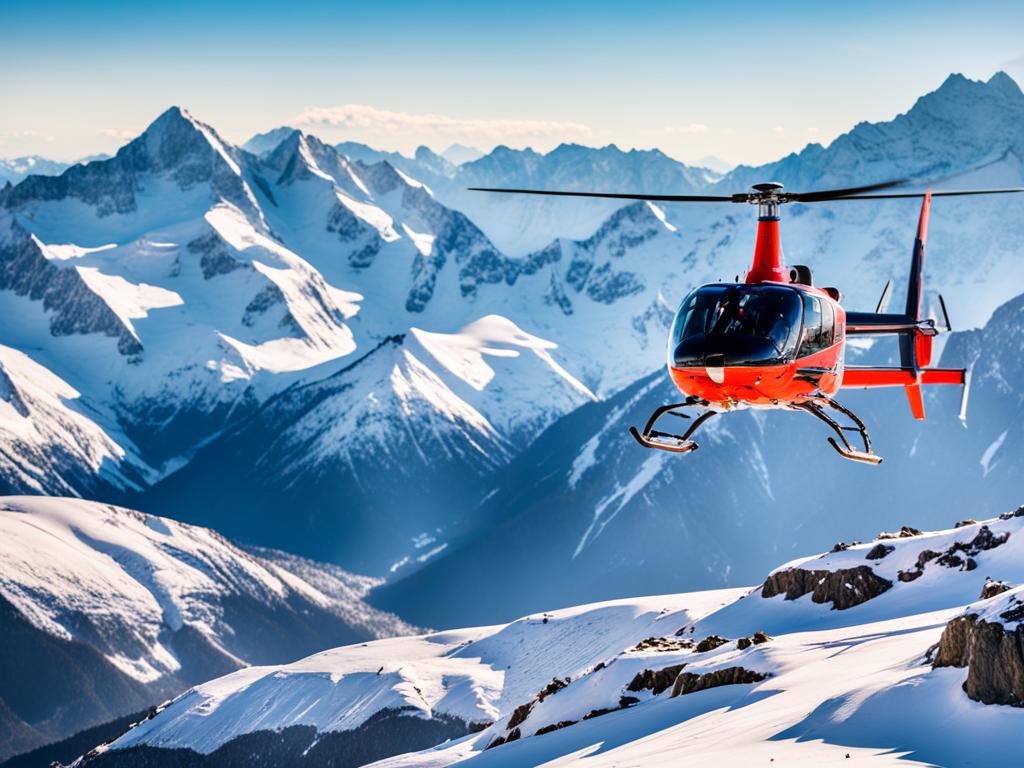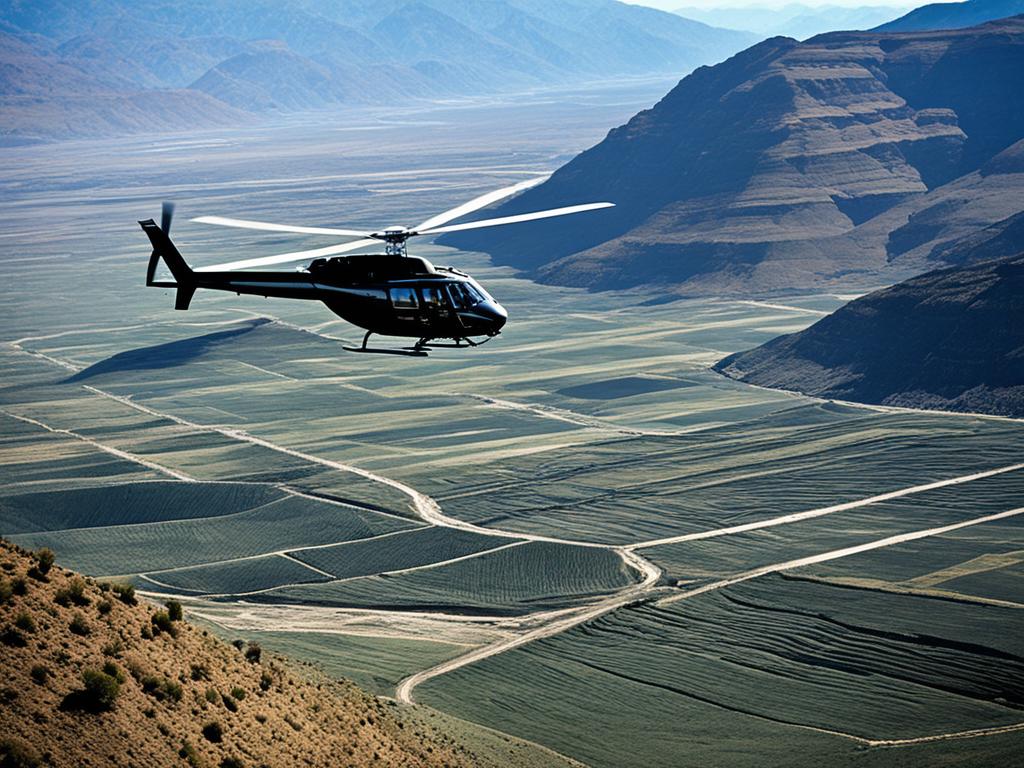Helicopters are truly remarkable machines, known for their flexibility and range of applications. As I explore the question of how far can a helicopter travel, I find that understanding a helicopter’s maximum range is essential. Typically, helicopters can cover average distances between 250 to 500 miles before needing to refuel. This flight distance largely depends on factors such as the helicopter type, weight, fuel capacity, and even prevailing weather conditions.
For instance, piston-engine helicopters usually have an impressive flight range of approximately 200-350 miles. In contrast, gas-turbine helicopters tend to go even further, reaching about 300-450 miles per flight. The advancements in military helicopters are particularly noteworthy, with some models having the potential to travel as far as 1200 miles with the help of in-flight refueling. This incredible range significantly impacts mission planning for diverse applications, including search and rescue, military operations, and commercial endeavors.
Table of Contents
Key Takeaways
- Average helicopter flight range typically falls between 250 to 500 miles.
- Piston-engine helicopters can average 200-350 miles, while turbine-engine models cover 300-450 miles.
- Military helicopters can exceed standard ranges, achieving up to 1200 miles.
- Multiple factors influence a helicopter’s flight distance, including weather and weight.
- Understanding helicopter range is essential for mission planning across various industries.
Understanding Helicopter Range
When discussing helicopter operations, an essential factor to consider is the helicopter range, which defines how far a helicopter can travel on a single tank of fuel. Understanding this range is crucial for planning flights, whether for rescue missions, commercial uses, or military operations. Multiple components affect helicopter endurance, including fuel capacity, weight, altitude, and environmental conditions.
Definition of Helicopter Range
Helicopter range speaks to the maximum distance a helicopter can achieve before necessitating a refuel. This capability hinges on various elements like helicopter fuel capacity and operational scenarios. For instance, payload weight impacts overall efficiency, as heavier loads require more fuel. Additionally, flying conditions—such as wind, temperature, and pressure—significantly influence the helicopter operating range.
Average Distances for Different Helicopter Types
The diversity in helicopter models leads to a broad spectrum of operational ranges. Piston-engine helicopters usually exhibit a range that spans from 200 to 350 miles. Comparatively, turbine-powered helicopters can extend their range to about 300 to 450 miles. Here’s a closer look at specific models and their distinctive ranges:
| Helicopter Model | Fuel Capacity (Gallons) | Range (Miles) | Speed (MPH) |
|---|---|---|---|
| Bell UH-1 Iroquois | 80 | 300-315 | 130 |
| Boeing CH-47 Chinook | 1,100 | 400-450 | 195 |
| Airbus H155 | 69 | 174 | 200 |
| MIL MI-26 | 3,000 | 497 | 110 |
| Robinson R22 | 26 | 250 | 110 |
| Bell 206 JetRanger | 70 | 385 | 130 |
| V-22 Osprey | 1,200 | 1,011 | 250 |
| Eurocopter X3 | 380 | N/A | 295 |
Each of these helicopters showcases distinct capabilities tied to their fuel capacity and design. Weather conditions play a substantial role in affecting the flights. Wind, in particular, can either hinder or boost a helicopter’s distance traveled, fundamentally influencing its fuel consumption and operating efficiency.
How Far Can a Helicopter Travel
Understanding the nuances of helicopter travel involves recognizing the variables that determine how far a helicopter can journey on a single tank of fuel. The helicopter flight endurance depends on several critical factors, including fuel capacity, payload weight, and environmental influences. Each of these factors plays a significant role in the overall helicopter distance achievable during a mission.
Factors Influencing Flight Distance
Multiple elements can impact how far a helicopter can go. Key factors influencing helicopter capacity include:
- Fuel Capacity: Larger fuel tanks allow for extended flight ranges.
- Payload Weight: Heavier loads require more power, increasing fuel consumption.
- Weather Conditions: Adverse weather can necessitate flight plan changes that affect distance.
- Operational Altitude: Higher altitudes can limit performance but may offer favorable winds.
Comparative Performance of Popular Helicopter Models
The range capabilities of different helicopter models vary significantly. To highlight this, I’ve compared specific helicopters that illustrate a broad spectrum of performance:
| Helicopter Model | Flight Range (Miles) | Speed (MPH) |
|---|---|---|
| Lockheed AH-56A Cheyenne | 1225 | N/A |
| Bell Boeing V-22 Osprey | 1011 | Max. 275 |
| Sikorsky S-92 | 620 | 160 |
| Airbus H155 | 600 | 200 |
| Robinson R44 | 300 | 110 |
| Bell 206 | 374 | 130 |
Models like the Sikorsky S-92 can cover impressive distances exceeding 600 miles, making them suitable for long-range missions. In contrast, lighter helicopters such as the Robinson R44 offer more limited ranges. Understanding the specific capabilities of each helicopter helps in choosing the right machine for various missions based on their required flight distances and capacities.
Applications of Helicopter Range
Understanding the various applications of helicopter range provides insight into their versatility and effectiveness across different sectors. Helicopters have proven invaluable in numerous areas, from emergency operations to commercial endeavors.
Use in Search and Rescue Operations
Helicopters are essential in search and rescue missions, largely due to their ability to reach remote locations quickly. The helicopter flight distance a model can achieve directly impacts its effectiveness in these urgent situations. For instance, the Sikorsky S-92 boasts a range of 1,000 km (621 miles), enabling extensive coverage during emergencies, while the EC 145, common in medical evacuations, covers up to 680 km.
Military Missions and Their Range Requirements
Military helicopter applications often demand extended flight ranges paired with in-flight refueling capabilities. Models such as the CH-47 Chinook and AH-64 Apache fulfill these requirements, allowing them to traverse substantial distances with heavy payloads. Their enhanced helicopter flight distance facilitates transporting troops and equipment effectively, showcasing their critical role in military operations.
Commercial and Tourism Uses
The commercial sector utilizes helicopters for diverse applications, including transporting personnel and supplies across challenging terrain. Ranges for commercial helicopter uses usually span from 200 to 1,300 km (124 to 807 miles), depending on the model. Helicopter tours offer unique perspectives of landmarks, making them a popular choice among tourists seeking unconventional experiences.

| Helicopter Model | Range (km) | Speed (km/h) | Passenger Capacity |
|---|---|---|---|
| Airbus H155 | 830 | 324 | 13 + 2 pilots |
| Sikorsky S-92 | 1,000 | 306 | 19 + 2 pilots |
| Bell 525 | 1,170 | 287 | 16 + 2 pilots |
| Airbus H175 | 1,300 | 315 | 16 + 2 pilots |
| EC 145 | 680 | 210 | 2 medical personnel + 1 patient |
This information highlights the impressive capabilities of various helicopter models, showcasing their adaptability and efficiency in meeting the distinct needs of multiple sectors.
Conclusion
As I reflect on the various aspects of helicopter flight, it becomes clear that the question of how far a helicopter can travel is multifaceted. The helicopter range significantly depends on factors such as the specific model, engine efficiency, weight, and operational needs. For instance, while turbine helicopters can reach impressive altitudes of up to about 25,000 feet, their fuel capacity and mission requirements dictate how far they can truly go before needing to refuel.
From my exploration, I’ve learned that different helicopters, such as the Bell 206 Jet Ranger with a ceiling of 13,500 feet, and the Eurocopter SA 315B Lama, can ascend to 23,000 feet, but their operational capabilities really come into play during mission planning. Understanding these limitations is vital, especially in critical situations like search and rescue or disaster response, where every second counts. Helicopters are also invaluable in industries like tourism and emergency medical services, demonstrating their ability to access remote locations that fixed-wing aircraft cannot reach.
Ultimately, embracing advancements in helicopter technology continues to enhance our understanding and expansion of operational capabilities. As the aviation industry evolves, so does the potential of helicopters—expanding not just their range, but also the possibilities of what they can achieve in countless scenarios. In a world where accessibility and efficiency are paramount, helicopters remain an indispensable asset.
FAQ
How far can helicopters fly before they need to stop or refuel?
The distance a helicopter can cover before needing to refuel typically ranges from 250 to 500 miles, depending on factors such as the helicopter type, fuel capacity, payload weight, and weather conditions.
What factors influence helicopter flight distance?
Several factors can affect a helicopter’s flight distance, including its fuel capacity, the weight of the payload, environmental conditions like weather, and the operational altitude during flight.
What is the difference in range between piston-engine and turbine-engine helicopters?
Piston-engine helicopters generally have a range of 200-350 miles, while turbine-engine helicopters can achieve a range of about 300-450 miles, offering more flexibility for extended missions.
Can military helicopters fly further than civilian models?
Yes, military helicopters, such as the CH-47 Chinook and AH-64 Apache, are built for longer missions and can even use in-flight refueling, extending their operational capabilities significantly, sometimes up to 1200 miles.
How does payload weight affect a helicopter’s range?
A heavier payload requires more power, leading to increased fuel consumption, thereby reducing the helicopter’s overall flight distance and operating range.
Why are helicopters important in search and rescue missions?
Helicopters can quickly access remote areas, which is vital in search and rescue operations. For instance, the Sikorsky S-76 has an effective range of nearly 400 miles, allowing extensive coverage during emergencies.
How far can commercial helicopters generally travel?
In the commercial sector, helicopters usually have a flight distance of 200-400 miles, allowing them to transport personnel and supplies to hard-to-reach locations efficiently.
What are some popular helicopter models and their ranges?
Popular helicopter models include the Sikorsky UH-60 Black Hawk, which can travel between 360-370 miles, and the Mil Mi-8, which has a range of about 280-310 miles, showcasing the variety in performance capabilities.

